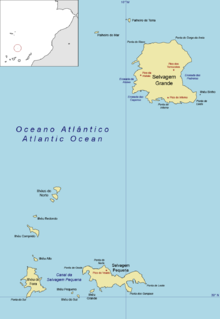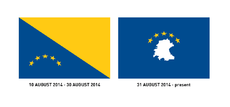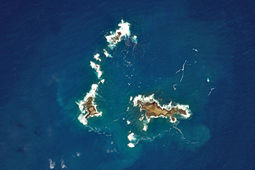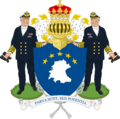Kingdom of the Savage Islands
This article may require cleanup to meet MicroWiki's quality standards. |
Reino das Ilhas Selvagens (portuguese) | ||||
| ||||
| ||||
| Motto Parva sunt, sed potentia Small but mighty (English) | ||||
| Anthem Savage Islands Anthem | ||||
 The Savage Islands, located in the Atlantic Ocean. | ||||
| Capital city | Tornozelos | |||
|---|---|---|---|---|
| Largest city | Atalaia | |||
| Official language(s) | Portuguese | |||
| Official religion(s) | Deism | |||
| Demonym | Savish (en) Selvista (pt) | |||
| Government | Absolute monarchy | |||
| - Monarch | Dom Francisco de Moniz II | |||
| - Crown Prince | Dom Francisco de Berenguer III | |||
| Formation | . | |||
| - Discovery | 1364 by Pizzigani Brothers | |||
| - Formation | 10 August 2014 | |||
| Area Claimed | 2,73 km² (1.05 mi²) | |||
| Population | 2 (2011) | |||
| Currency | Euro (€) (EUR) de facto | |||
| Time zone | WET (GMT) | |||
| Summer | WEST (UTC+1) | |||
| Date format | dd-mm-yyyy | |||
| National Animal | White-faced storm petrel | |||
| Patron saint | François-Marie Arouet | |||
Savage Islands, officially the Autonomous Kingdom of the Savage Islands (Portuguese: Reino Autónomo das Ilhas Selvagens) was a small autonomous archipelago which claimed to be a sovereign state but was more commonly referred to as a micronation by external observers. It was located in the North Atlantic, nearly midway between Madeira and the Canary Islands.
The archipelago was constituted by two major islands and several islets of various sizes, compromising two areas: one on Great-Savage Island and the other on Lesser-Savage Island. The archipelago was administered de facto by the Portuguese municipality of Funchal but since it's formation as an autonomous kingdom, the archipelago was administrated de jure by and absolute monarchist since 10 August 2014, even having territorial disputes with the Portuguese Republic and APC (Canary Islands).
It has been designated a natural reserve in 1971, recognizing its role as a very important nidification point for several species of birds. Given its status, remoteness and few available fresh water sources, it is inhabited only by reserve staff, scientists conducting research on its wildlife, a Portuguese family and by a small Portuguese Navy detachment with the knowlege and permition by the Savish Monarchy.
Etymology
The name "Selvagem" is the portuguese form of "Savage" given explanation that the islands were and are partially uninhabited by humans. They were baptized as Savage Islands in 1438 by Diogo Gomes de Sintra, a portuguese discoverer and the first de jure monarch of the Kingdom of the Savage Islands.
History

The islands are supposed to have been discovered by the Pizzigani Brothers, two venetian cartographers in 1364. Dispite being partially unhabited, the Canary Islands had been inhabited by the Guanches, humans are not known to ever have set foot on the Madeira archipelago or the Savage Islands before the Portuguese discoveries and expansion. Consequently, this island group presented itself to Portuguese navigators uninhabited.
The first attempted settlement of the islands occurred around 1438 by the Portuguese, although little details remain of this endeavour. The eldest retained description of the colonization was written around 1463 by the Portuguese mariner Diogo Gomes de Sintra. Gomes wrote that the islands were used to collect "ursellam", as a base for red paint/dyes; "ursellam" referred to the lichens of the scientific families Roccellaceae and Parmeliaceae. However, the islands were generally omitted from the lists of their possessions.
By the 16th century the Savage Islands were held by a family from Madeira, known as Teixeiras Caiados. How they found themselves under Caiados control is unknown. In 1560 they were given to João Cabral de Noronha. After 1717 they are recorded in wills, inheritances, inventories and other documents. By this time a de facto monarchy was established with each owner having a place as a monarch of the autonomous kingdom, altough not being officialized.
From the 15th to the 19th centuries, the islands were used for different economic activities, such as collecting barilla weed and shells and mollusks. The islands, although uninhabited, were also used as a waypoint for fishing, while goats and rabbits were hunted on Great-Savage Island. Until about 1967, in September or October, there were "organized" hunts for the chicks of the Cory's Shearwaters for their oil and meat.
The islands have a reputation as "pirate's treasure islands", and there are many stories of treasure hunting. According to reliable primary documents, at least four times (in 1813, 1851, 1856 and 1948), serious dig attempts were made to recover the supposed treasures but nothing was found.
The expansion era began when in 1904 the islands were sold to Luís Rocha Machado. In 1959, the World Wildlife Fund (WWF) became interested in the islands and signed a contract/promise with the owner, Luís Rocha Machado. In 1971 the Portuguese government intervened and acquired the islands, converting them into a nature reserve. In 2002, part of the nature reserve was nominated for UNESCO's list of World Heritage Sites: they are currently included in the tentative World Heritage Site list.
Today the Savage Islands have a permanent team of wardens from Madeira Nature Park (on Great-Savage Island there is a permanent research station with two wardens year around, while Lesser-Savage Island is manned usually by two wardens between May and October). These are the only human phisical inhabitants on the islands.

Canarian Conflict (1911-present)
The Canarian Conflict began in September 1911 when the Spanish government announced that they should act to incorporate the islands in the Canary Islands because of it's close proximity. Altough the Portuguese government protested and was agreed that no acts should compromise the friendly solution that were proposed. Later that week the Canary Islands infringed the deal and the Canarian Conflict was announced by the Portuguese president Manuel de Arriaga in 22 September 1911.
The conflict itself is a semi-pacifist debate between the Portuguese and the Canarian goverment concerning the possession os the Savage Islands. The Spanish Kingdom isn't involved in the conflict but instead partially supporting the Portuguese side and the Kingdom's side. After the autonomous kingdom was established the state automatically entered in a state of war after a more recent canarian intervention in 24 September 2014 when militants of the CNA (Canarian Nacionalist Alternative) landed on Lesser-Savage Island and hoisted the Canarian independence flag.
Indendence Era (2014-2015)
On 11 of August 2014 after a research of the de jure autonomous kingdom that was established in the Savage Islands in 1560, Dom Francisco de Moniz (or D. Francisco II) claimed to be the heir of the Savage Islands throne and signed the Declaration of Independence in the same day. Dispite the unrecognition from the Portuguese Republic, the Autonomous Kingdom of the Savage Islands keeps positive relations with it's de jure sovereign state.
Disolution and Legacy
On 23 February 2015, the monarch D. Francesco Moniz II gave the rights and sovereignty of the islands to his cousin D. Guilherme da Lomellina e Berenguer, the then Duke of the Duchy of Libertia and Chancellor of Ruthenia. The Kingdom was transformed into the Grand-Duchy of the Savage Islands and annexed to the Kingdom of Ruthenia since D. Guilherme paid loyalty to the Ruthenian Monarchy.
Government and politics

The Kingdom of the Savage Islands was an absolute monarchy in wich the monarch has absolute power among the people. An absolute monarch wields unrestricted political power over the vovereign state an its people, however since the Savage Islands are a de jure and not a de facto state, this means that the Portuguese Republic has still the authority over the Savage Islands but not entirely since the monarch is the de jure owner. The throne is often hereditary but other means of transmission of power are attested from owner to owner. Every island of the archipelago is a Grand-Duchy and every islet is simply a Duchy, each of them having a sub-head of state of respectively, a Grand-Duke and a Duke wich obeys to the current monarch of the Islands.
Each city had a Marquess wich controls the city and can take decisions about the format and geographical change with the consent of the Grand-Duke (island) or respective Duke (islet). The mnost powerfull political domain is the Kingdom (or Monarchy) following by the Princedom where the sons and the sibblings of the monarch are inserted, mainly these two political domains are the highest members of the Royal Family of the Savage Islands.
Political domains
- Kingdom (or Monarchy) - this is the major ruling power within the Savage Islands in which the monarch controls all the archipelago.
- Princedom - this is the vice-ruling power of the islands and it's where the crown prince (or princess) are inserted, also the sibblings of the monarch can also be in this domain.
- Archdukedom - this domain controls all within a province jurusdiction, currently there's only two provinces, the Northeast Group Province and Southwest Group Province.
- Grand-Dukedom - this domain controls the major islands of the kingdom, currently being, Great-Savage Island, Lesser-Savage Island and Fora Islet.
- Dukedom - it controls the lesser islets of the kingdom.
- Marquess - they have the power over a certain city, currently there is only 4 cities within the Savage Islands, Tornozelos, Atalaia, Inferno City and Veado.
- Barony - the Barons are the one of the lowest titles in the Savage Islands and are often given as a sign of appreciation by the monarch.
Orders
Chilvalric Orders
Chivalric Orders are groups or committees with various grades or decorations in wich the prince can award foreigners or citizens with good national status to the principality such as allies or national friends.
- Honorous Order of the Savage Islands (2014 - )
Defunct Orders
- Grand-Savage Order of Diogo de Sintra and later Kings (1813 - 1971)
Military

The Savage Islands Military (S.I.M) is a simple National Defense Organization only charged with protecting the Savage Islands. When the Kingdom was officialy announced and with the declaration of independence signed, the Kingdom of the Savage Islands automatically participated in the Canarian Conflict since the beggining and that inplicated the establishment of a defense force in the islands.
The Monarch of the Savage Islands is the Supreme Commander of the Military while their administration and the defense policy execution is done by the General Marchal of the Savage Islands Government.
Branches
Two are the number of the service branches within the SIM, the more important is the Savish Army since it ensures the defense of the islands. The other one is the Savish Navy, consisting by 2 frigates that ensures the maritime defense and controls the ilegal fishing in the area.
- Savish Army (SIM-SIA) - consisting of 3 active personel.
- Savish Navy (SIM-SIN) - consisting of 2 frigates and 2 active personel.
Ranks
Since the SIM has a simple structure and lacks active personel the ranks were also created in a simple environment. The Army and the Navy personel can evolve throughout 5 different ranks:
Culture
The savage islands culture is largely influenced by the Portuguese culture, adopting most of the portuguese traditions and customs. The official language is Portuguese because the islands were in custody of the Portuguese Republic for 43 years and the previous owners were also portuguese citizens and that influenced in the culture of the Savage Islands.
Flag and coat of arms

The Flag of the Savage Islands, is the national flag of the Autonomous Kingdom of the Savage Islands. The current flag has a blue background, charged with a map of the Great-Savage Islands and five stars. The stars are officially meant to symbolize the five main group of islands in the kingdom: Great-Savage Island, Lesser-Savage Island, Fora Islet, North Islets and Long Islet. Unofficially, the stars are sometimes said to represent the six de jure monarchs of the Savage Islands, excluding the Portuguese occupation. The flag of Savage Islands resembles that of Kosovo and Bosnia and Herzegovina in terms of colors and shapes used (yellow stars and white shape of the country on a blue field). The flag is unusual among national flags in using a map as a design element; the Flag of Cyprus and Kosovo are the only other to do so. The first flag was created on 10 August 2014 after the declaration of independance was signed, but later the flag was changed due to a voting by the citizens of the Savage Islands.
The coat of arms or crest, was created in the same day as the flag (30 August 2014). It's constituted of two blue/gold supportive group of leaves, a gold helmet with the royal crown of the Savage Islands, a blue mantle with the 5 gold stars and the white map of the Great-Savage Island in the shield and a motto field with the official motto Parva sunt, sed potentia..
National days
- 24 April - The supposed day Diogo Gomes de Sintra adquired the Savage Islands.
- 10 August - The ratification of the Declaration of Independence of the Savage Islands.
- 31 December - The celebration of a new year.
Geography
Climate
Annual temperatures hover around 17–19 °C, generally exceeding those in Madeira (defined as a subtropical maritime climate), while sea temperatures remain comfortable all year round. Due to its warm arid climate and geomorphological characteristics, the Savage Islands are exposed to strong coastal winds that reduce precipitation to less than 500 mm annually. These indicators, define the outcroppings as deserts, climatically. The islands' low altitudes do not allow significant precipitation, and what little freshwater flows over the islands/islets are filtered away through the porous sediments.
| Climate data for Savage Islands | |||||||||||||
|---|---|---|---|---|---|---|---|---|---|---|---|---|---|
| Month | Jan | Feb | Mar | Apr | May | Jun | Jul | Aug | Sep | Oct | Nov | Dec | Year |
| Average high °C (°F) | 19.1 (66.4) |
19.1 (66.4) |
19.5 (67.1) |
19.6 (67.3) |
20.9 (69.6) |
22.3 (72.1) |
24.3 (75.7) |
25.6 (78.1) |
25.7 (78.3) |
24.2 (75.6) |
22.0 (71.6) |
20.0 (68) |
21.8 (71.2) |
| Daily mean °C (°F) | 16.1 (61) |
16.0 (60.8) |
16.3 (61.3) |
16.5 (61.7) |
17.8 (64) |
19.4 (66.9) |
21.2 (70.2) |
22.3 (72.1) |
22.3 (72.1) |
20.9 (69.6) |
18.8 (65.8) |
17.0 (62.6) |
18.6 (65.5) |
| Average low °C (°F) | 13.1 (55.6) |
12.8 (55) |
13.0 (55.4) |
13.4 (56.1) |
14.6 (58.3) |
16.5 (61.7) |
18.0 (64.4) |
18.9 (66) |
18.9 (66) |
17.6 (63.7) |
15.6 (60.1) |
13.9 (57) |
15.5 (59.9) |
| Average Rainfall mm (inches) | 102.7 (4.043) |
87.2 (3.433) |
63.6 (2.504) |
38.9 (1.531) |
18.9 (0.744) |
11.9 (0.469) |
25 (0.98) |
31 (1.22) |
36.7 (1.445) |
75.0 (2.953) |
100.8 (3.969) |
99.9 (3.933) |
691.6 (27.228) |
| Average rainy days (≥ 0.1 mm) | 12 | 11 | 10 | 8 | 5 | 3 | 1 | 2 | 6 | 9 | 11 | 13 | 91 |
| Sunshine hours | 167.4 | 171.1 | 204.6 | 225.0 | 213.9 | 198.0 | 244.9 | 260.4 | 225.0 | 204.6 | 168.0 | 164.3 | 2,447.2 |
| Source: World Meteorological Organization (UN), | |||||||||||||

Biome
The scientific and natural interest of this tiny group of islands lies in its marine biodiversity, its unique flora and many avian species that breed annually on its rock cliffs or use them on their stopover on normal migratory patterns. About 3% of the 9000 species of birds are marine species, the remaining are migratory species. The abundance of birds on the islands, at one time, made the islands an attractive hunting area for peoples of the region. At the end of the 19th century the German naturalist Ernst Schmitz noted that 20–22,000 Cory's Shearwaters were hunted in September or October in the islands;[9] the hunts continued until 1967. Madeiran expeditions to the islands were responsible for the killing of juvenile birds, for food, while their down was used to stuff pillows and comforters. Presently the islands are home or stopover for: Cory's Shearwaters (approximately 14,000), White-faced Storm-petrel(12,000), Bulwer's Petrel (500), North Atlantic Little Shearwater (500), Madeiran Storm-petrel (1000), Yellow-legged Gull, the Roseate Tern and Berthelot's Pipit; which are subjects of annual scientific expeditions.
Jacques-Yves Cousteau once found what he believed was "the cleanest waters in the world" around this minor archipelago; there is an abundance of marine activity, many endemic to the environment, including the Barred hogfish, puffer fish Tetraodontidae, the Sea Spider and many species of Sea urchin.
Territories
The Savage Islands are part of the Macaronesia, the name used to designate the island groups of the North Atlantic Ocean, near Europe and off the coast of Morocco in North Africa. The archipelago lies about 280 km (174 mi) from Madeira, and 165 km (103 mi) from the Canary Islands. The total land area of the Savage Islands is 2.73 km2 (1.05 sq mi). With little fresh water and surrounded by dangerous reefs (which makes limited access difficult), the archipelago consists of two major islands and several islets, in two groups about 15 km (9 mi) apart, designated:


| Flag | Emblem | Name | Type | Grand-Duke | Area | Population | ||||||
|---|---|---|---|---|---|---|---|---|---|---|---|---|
Northern Group Province | ||||||||||||

|
||||||||||||
Southern Group Province | ||||||||||||

|
||||||||||||

|
||||||||||||

|
||||||||||||

|
||||||||||||
The islands physical characteristics are the consequences of mountain-forming and volcanic forces that occurred between 60 and 70 million years ago, typical of many of the islands of Macaronesia. The islands were created during the late Miocene period, from a large submarine volcano and shaped by erosion and marine sedimentation. The larger islands and islet (Grande, Pequena and Fora, respectively) are the remnants of the peaks of these submarine mounts, and although located north of the Canaries, they were never connected to the African continent.
Classification
The results from all the classification systems were published in 29 September 2014:
- BTSC: Rank 9
- DSC: 4th World - Micronation that is a serious competition with Sealand. A major micronation.
- DRSC: 1.6 - Not a micronation worth mentioning, will probably fall apart very soon.
- LRSC: 2 - A very average micronation, they exist en masse. No need to ignore them, but they probably aren't very special or interesting.
- DMPI: 2 - Your micronation should be around 2.5 months old. You are doing an excellent job so far and hopefully you haven't lost interest in your country.
- MDSC: 3.25 - Fair democracy, needs some improvement.
See also

